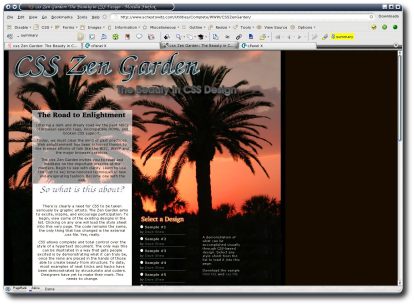Interfaces Commonality

KDE‘s Konqueror menu bar

Firefox menu bar
Firefox is Mac OSX-themed (Download/install)
 t is no secret that various software vendors use similar conventions for menu layouts, icons and so forth. As an instance, have a look at the one-to-one correspondence in the screenshots above (
t is no secret that various software vendors use similar conventions for menu layouts, icons and so forth. As an instance, have a look at the one-to-one correspondence in the screenshots above (Edit, View, Go, Bookmarks, Tools, Help) where even menu accelerators are identical. It is inevitably so because consistency needs to prevail. Users who moves from one piece of software to another must be able to re-orientate quickly by identifying familiar phrases and labels (terminology) or images.
What impact does that have on innovation and diversity though? The most rational interface will not necessary make it easiest for the user to adapt to. For example, Windows users are accustomed to going to “Start” when they want to End the current session. Is that not preposterous? Yet, if this convetion gets changed, this will probably result in confusion.
Software that is most usable is one which implements control interfaces that most users are familiar with. Familiarity of the novice users is influenced by high-impact software such as Windows or Photoshop. Due to the nature of this trend, imitation becomes easier to claim. In fact, this would be one reason for the scare among anti-software patents activists. The main sufferer would be the user who needs to master different distinct interfaces and ends up in a lock-in situation, whereby migration between software packages become an ardonous experience.
Finally, let us consider a practical example where the damage of patents is apparent. Xerox sued Palm for the use of Graffiti — a one-stroke method for inputting text, which they claimed they had patented. As a result, Graffiti 2 (see criticism) emerged so Palm users had to throw away years of experience, learning a new ‘handwriting’ method, which involved 2 strokes rather than just one.






 Filed under:
Filed under: 



 Yahoo have recently introduced nice features such as
Yahoo have recently introduced nice features such as 
 or quite some time I have been wanting to create a
or quite some time I have been wanting to create a  The latest generation of Web development involves tools such as the one used for managing this Web log. Although many pages continue to be composed in the level of raw HTML code or using What You See Is What You Get (WYSIWYG) tools, their days appear numbered. Quite simply, both are antiquated methods of composing for the Web since development is usually done at the remote end — the user’s end. Both content and tools (software) reside on the user’s side. Content then needs to be transferred to the Web server and software is not guaranteed to work on any platform.
The latest generation of Web development involves tools such as the one used for managing this Web log. Although many pages continue to be composed in the level of raw HTML code or using What You See Is What You Get (WYSIWYG) tools, their days appear numbered. Quite simply, both are antiquated methods of composing for the Web since development is usually done at the remote end — the user’s end. Both content and tools (software) reside on the user’s side. Content then needs to be transferred to the Web server and software is not guaranteed to work on any platform.